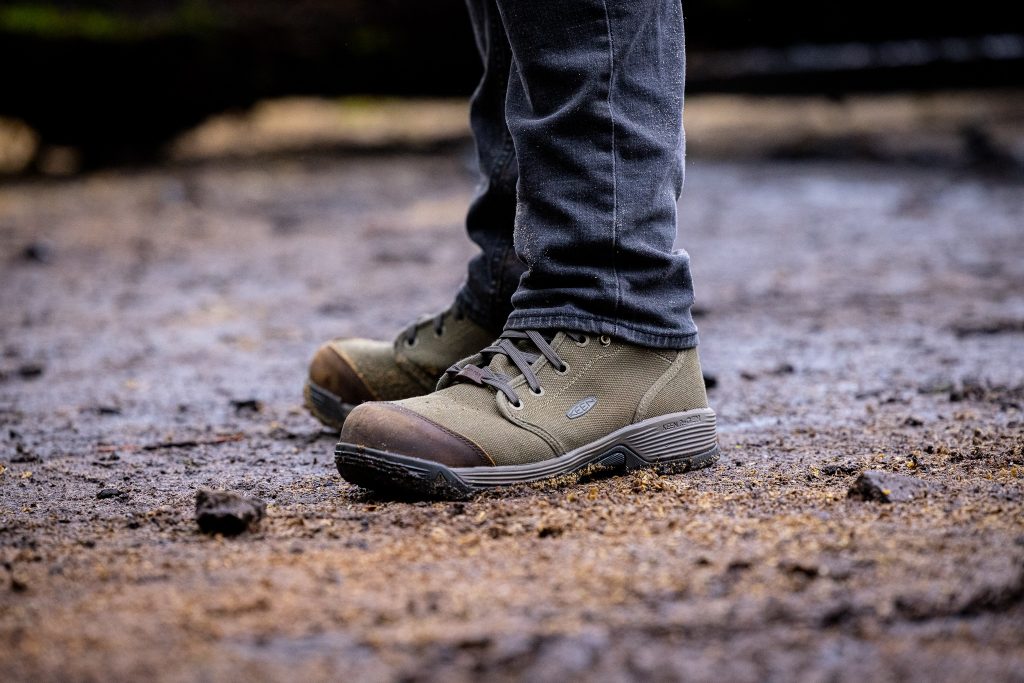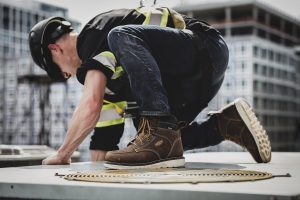
Selecting safety footwear
By ROBIN SKILLINGS
Construction Equipment Technology Health & SafetyWhat to look for in a new work boot.
It can be tough to let go of a favourite pair of work boots. Those comfortable standbys have worked hard for miles and become so broken in, it’s hard to understand how they may not be working to their optimal performance anymore. When it comes to preventing injuries on the job and ensuring the best in performance and comfort, knowing when it is time to start shopping for a new pair can be critical.
With so many options to choose from, it can be overwhelming to select new footwear that not only satisfies safety requirements of the job at hand, but also offers the performance and comfort features that will help get the job done over the course of a long day of work.
SIGNS YOUR BOOTS SHOULD BE REPLACED
Sometimes knowing when it is time to replace an old pair of work boots can be self-explanatory. If work boots have visible holes and cracks or are literally falling apart at the seams, it is time for a new pair.
However, when it comes to boot replacement, there are some less obvious indicators to look out for as well. For example, an overly pliable boot suggests that the shoe no longer has the structural rigidity it possessed at the time of purchase. Delamination of the outsole is another sign and is visible when the outsole of your boot starts separating from its leather or fabric upper. This occurs when the cement construction of the shoe wears out due to either the age of the glue or exposure to caustic materials.
Even protective toe caps can become damaged over time and need replacement. This is especially important after a cap takes a blow regardless of any visible PPE damage as micro-cracks can develop making toe caps significantly less effective.
SELECTING NEW SAFETY FOOTWEAR
When the time finally comes to unlace a pair of boots for the last time, there are many factors to take into consideration when it comes to looking for new footwear. Different work sites have unique requirements for personal protective equipment (PPE) and that includes safety footwear.
In addition to choosing a shoe that meets the specific safety demands, performance and comfort enhancements should not be ignored. You are wearing these boots all day, after all! These features must also be considered to not only maximize productivity over the course of a long workday but improve foot health as well.
In Canada, a few factors to consider include:
CSA certification: A prerequisite for Canadian jobsites is a CSA-certified boot. Puncture-resistant outsoles are a critical component of this certification, and help prevent sharp objects, such as nails, from piercing through the outsole and causing injuries underneath the foot.
In the past, this extra layer of protection, which can be found in the boot’s midsole, were constructed from metal plates such as steel. However, thanks to material advances, this layer can now be constructed from high-tensile strength woven fabrics, which are lightweight and flexible as well as non-metallic options that offer the necessary puncture resistance for the jobsite.
Slip resistance: Slips, trips, and falls are some of the most common injuries on the jobsite. In fact, according to Onatrio’s Workplace Safety and Prevention Services, one in five lost-time injuries result from falls.
Slip resistant outsoles minimize this risk through an interlocked tread pattern ingrained under the outsole. This pattern channels liquid away from the foot, providing increased surface area and better overall traction.
In Canada, CSA certification also requires the labeling of slip-resistance performance data on all safety footwear. Reviewing a boot’s box and label or checking the brand’s website to find the CSA seal of approval is essential prior to purchase.
Toe protection: Safety toe caps are often required on jobsites, especially when working with heavy machinery or lifting heavy objects. Traditionally, safety toes were made of steel or aluminum, however carbon-fibre toes are the latest safety cap to enter the market.
Carbon-fibre safety toes are 15 per cent lighter than steel, which provides a new-found mobility and comfort for workers. Additionally, these caps are non-metallic, which is extremely beneficial for workers whose jobs require them to pass through metal detectors throughout the day. At my company, both comfort and safety are paramount, which is why safety toes are asymmetrical to provide a roomier and more comfortable fit.
Unique safety features for the job: Every job has its own specific requirements for potential risks. Depending on the potential hazards of the individual jobsite, there is likely a safety footwear option that offers the needed protection.
These features could include everything from abrasion-resistant outsoles for worksites where water, grease or any other liquids are common, to Kevlar fibre for resistance against open flames. Whatever presents potential danger at a jobsite, it is essential to select footwear with the safety features that correspond with the job at hand.
Seasonality: Although many work boots are made for year-round use, there are benefits to purchasing boots specific for the summer or winter months. For example, insulated and waterproof boots are important in the colder months to keep feet warm and dry. However, as summer rolls around, transitioning into a work boot that is lighter with more breathability may be attractive when it comes to keeping feet cool during the warmer months.
FINDING THE RIGHT FIT
Selecting a work boot that fits well is crucial in order to prevent injuries and maximize comfort over a long day on your feet. When it comes to shopping for a new boot, we recommend trying shoes on at the end of a shift. This is because the feet naturally swell over the course of the day, so this is when they will be at their largest.
Additionally, when determining the best fit, it is important to try on new boots while wearing the socks that will be worn while on the job. Companies are constantly innovating new footwear enhancements so there are increasingly more options when it comes to underfoot support, improved performance, and even extended lifetimes of work boots.
Robin Skillings is the vice-president and global general manager at KEEN Utility, a leading industrial and service footwear brand.







